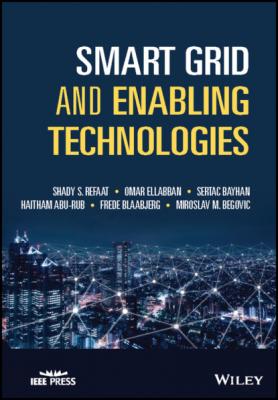Smart Grid and Enabling Technologies. Frede Blaabjerg
Читать онлайн.| Название | Smart Grid and Enabling Technologies |
|---|---|
| Автор произведения | Frede Blaabjerg |
| Жанр | Физика |
| Серия | |
| Издательство | Физика |
| Год выпуска | 0 |
| isbn | 9781119422457 |
13 Chapter 13Table 13.1 Possible enablers and barriers of end‐user engagement in SG projec...
14 Chapter 14Table 14.1 The criteria of cloud computing prospective.
15 Chapter 15Table 15.1 List of the ML‐based AI review papers for 2020.Table 15.2 Mainstream DL architectures with their advantages, limitations, an...Table 15.3 List of hybrid models for smart energy applications.Table 15.4 Comparative study of the proposed methods.Table 15.5 Comparative study of metaheuristic algorithms for SG applications.Table 15.6 Most popular error measures for regression tasks.Table 15.7 Classes of score metrics.Table 15.8 Short‐term SG‐based AI applications.Table 15.9 Medium‐term SG‐based AI applications.Table 15.10 Long‐term SG‐based AI applications.
16 Chapter 17Table 17.1 Overview of standards.
List of Illustrations
1 Chapter 1Figure 1.1 The fundamentals of electric power system. Adapted from Ref Num [...Figure 1.2 Selection of rated voltage for three‐phase AC transmission line. ...Figure 1.3 Main types used in electric power distribution, (a) Redial feeder...Figure 1.4 Traditional power grid.Figure 1.5 The conceptual model of SG framework. Ref [18]. Reproduced with p...Figure 1.6 SG components.Figure 1.7 Main key technology areas of smart grid.Figure 1.8 Distributed energy resources paradigm in smart grid. Ref [20]. Re...Figure 1.9 The distributed energy storage system.Figure 1.10 Schematic diagram communication infrastructure for the SG.Figure 1.11 Customer engagement demand side management spending by region, 2...Figure 1.12 Distributed operation architecture with two levels.Figure 1.13 Decentralized operation architecture.Figure 1.14 Local operation architecture.Figure 1.15 Central operation architecture.Figure 1.16 Classification of DR.Figure 1.17 The difference between the conventional power grid and smart gri...Figure 1.18 Three trends of the grid edge transformation.Figure 1.19 Technologies for the evolution of the SG.Figure 1.20 Fishbone diagram showing gaps.Figure 1.21 The main stages for achieving grid modernization.Figure 1.22 SG role in the electricity power sector.Figure 1.23 SG investment. Adapted from [89].Figure 1.24 SG costs Ref [90]. Reproduced with permission from EPRI (Electri...
2 Chapter 2Figure 2.1 Flowchart of the common renewable energy sources.Figure 2.2 Renewable energy resources theoretical potential.Figure 2.3 Total renewable power installed capacity (GW), including its annu...Figure 2.4 Main features of the bioenergy energy technology. Adapted from [1...Figure 2.5 Bioenergy conversion processes for different end products.Figure 2.6 Global biomass cumulative installed capacity, 2000–2013. Ref Num ...Figure 2.7 Biomass installed capacity for energy systems (2010–2025). Ref Nu...Figure 2.8 Cumulative installed geothermal generating capacity by top 10 cou...Figure 2.9 Global geothermal installed capacity from 1950 up to 2019 and its...Figure 2.10 Hydropower generation by top 10 countries in 2019. Adapted from ...Figure 2.11 The evolution of world hydropower generation since 1980.Figure 2.12 Global ocean power capacity forecasting.Figure 2.13 Global integrated solar PV capacity from 2000 to 2019.Figure 2.14 Solar PV global capacity by top 10 countries in 2019.Figure 2.15 PV shares of grid‐connected (distributed and centralized) and of...Figure 2.16 Global installed concentrating solar power capacity, 2000–2019....Figure 2.17 Concentrating solar power capacity in the top 10 countries in 20...Figure 2.18 Solar water heating collectors’ global capacity, 2000–2019.Figure 2.19 Solar water heating collector capacity by top 10 countries in 20...Figure 2.20 Growth in capacity and rotor diameter of wind turbines, 1985–201...Figure 2.21 Total installed global wind power capacity, 2000–2019.Figure 2.22 Installed wind power capacity, top 10 countries in 2019.Figure 2.23 Wind power market forecast for 2017–2021. Ref [55]. Reproduced w...Figure 2.24 Predicted world total installed renewable generating capacity, 2...Figure 2.25 Predicted world renewable electricity generation and their globa...Figure 2.26 Potential features of renewable energy sources integration.Figure 2.27 Financial investments in renewable energy by technology, 2004–20...Figure 2.28 Research and development costs on renewable energy, 2004–2019, A...Figure 2.29 Global employment in renewable energy 2011–2018, Adapted from [5...Figure 2.30 Renewable energy market development process, [9]. Reproduced wit...Figure 2.31 Barriers to renewable
